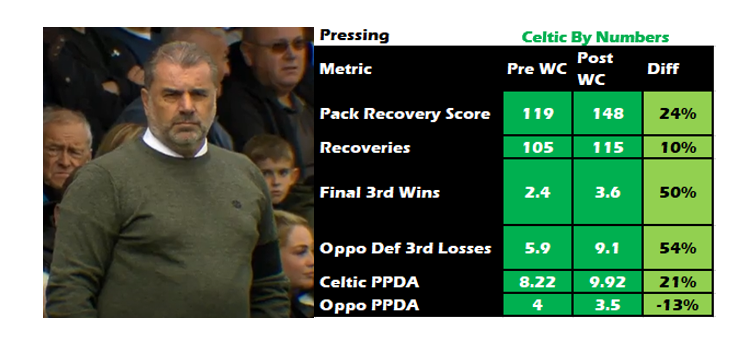On this week’s Huddle Breakdown (please subscribe on whatever channel you consume your podcasts) @jucojames spelt out how some of Celtic’s key metrics have declined since the World Cup hiatus.
And they are some core metrics, for sure.
Looking at Scottish matches only, expected goals (xG) is down from 2.99 to 2.82.
Celtic are having less quality shots – xG per shot is down from 0.16 to 0.15.
The Champions are not working the opposition goalkeepers any more – average about four saves per game pre and post-World Cup.
But, the cost to the opposition of shackling Celtic is immense. xG against has dropped from 0.84 to 0.68 and xG per shot has fallen radically from 0.14 to 0.1.
We have seen in recent games that even when teams go two, three or four goals behind they still maintain a deep and dense defensive shape. That comes at a cost to their attacking potency.
So, it is not a bad story, but have Celtic’s performance been blunted?
Defending
As mentioned, teams in Scotland are suffering in the trade off between stopping the scoring at one end and creating at the other.

The only negative is that Celtic are getting on average one more defender taken out the game per 90m. This is likely the cost of playing very high full backs and quite a high line in general.
In all other respects, Celtic are limiting the opposition to a greater extent. Joe Hart is making 41% less saves admittedly from a low base.
In general, the opposition attacking is around 15% less effective.
Build Up
Here are a few befores and afters on build up data:

Pack receives are where a player takes a forward pass under control that has taken opponents out the game.
Taking defenders out the game really messes the opposition shape and that is up 35%.
So, despite playing deeper and more compact defences, Celtic are finding their way through the opposition lines to a greater extent.
My take is that rather than taking the bait and going wide, Celtic are attempting more through balls and passes to a player in the box under pressure and trusting control and strength to work the balls into promising positions centrally. In particular we have seen Greg Taylor and Reo Hatate taking on high risk passes that are more central in target.
Let’s look at some of the attacking threat data.
Attacking Threat

We are not yet seeing the improved attacking build up transmit into more goals or even xG, but more touches in the box and a higher overall Attacking Threat (CAT) score suggests the more incisive build up will result in more goals eventually – hopefully starting Sunday!
Pressing
It is off the ball that has seen perhaps the biggest improvements in Celtic’s cohesion and team work.

Celtic are forcing more turnovers that result in the opponents having players “wrong side” of the ball – up 24%.
They are winning the ball back more often in the opponents defensive third and forcing the opponent to lose possession in their own defensive third – both have improved by 50%+.
Consequently, Celtic are forcing the opponents to complete 13% less passes per defensive action whilst completing 21% more themselves.
Summary
The data supports the eye test that since the World Cup break, Celtic are becoming a highly organised and relentless team.
Despite the score board and indeed underlying xG not showing improvements, all the building blocks are in place to see Celtic’s goal output rise.
In particular, off the ball, Celtic’s pressing and hounding of opponents is becoming increasingly effective. One might say relentless.
They are also successfully working the ball into good areas despite blanket defences.
Someone could get a right doing soon.
It would be a shame if it was a team with a (Mickey) Rookie Manager.

Last year we heard from various sources that year two of the Ange footballing philosophy is when his teams really start to show. Your numbers Alan, are bearing that out.
One ‘doing’ coming right up! One mountain of arrogance reduced to a molehill of inherited deficit and increased goal difference coming right up!
T